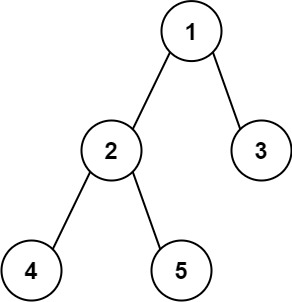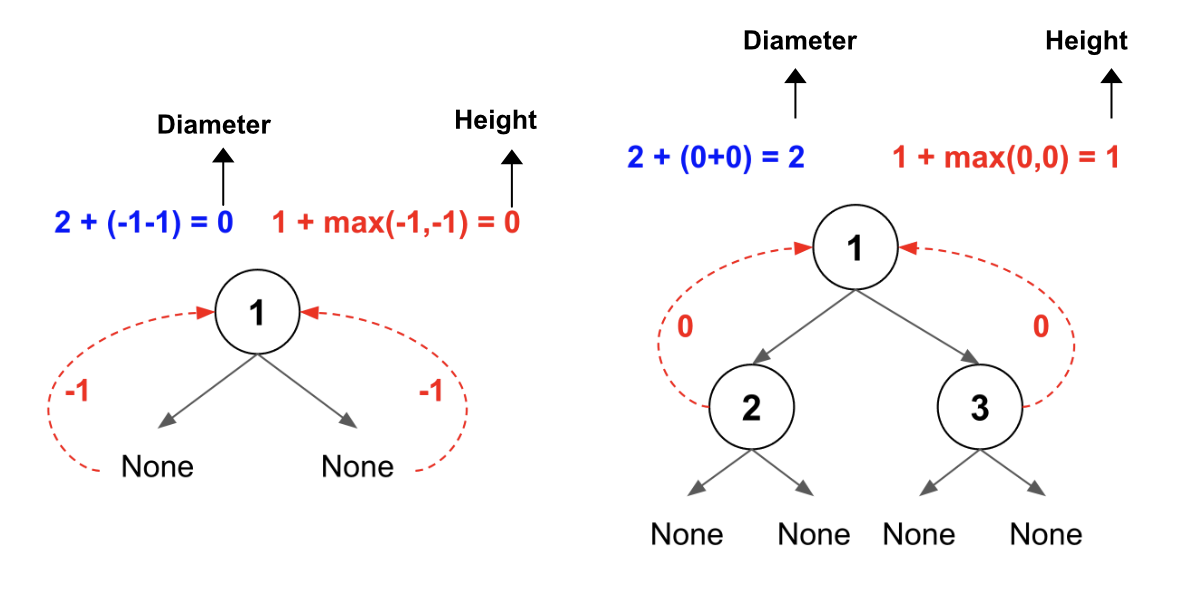Tree - Diameter of a Binary Tree
All diagrams presented herein are original creations, meticulously designed to enhance comprehension and recall. Crafting these aids required considerable effort, and I kindly request attribution if this content is reused elsewhere.
Difficulty : Easy
PostOrder DFS
Problem
Given the root of a binary tree, return the length of the diameter of the tree. The diameter of a binary tree is the length of the longest path between any two nodes in a tree. This path may or may not pass through the root. The length of a path between two nodes is represented by the number of edges between them.
Example 1:
1
2
3
Input: root = [1,2,3,4,5]
Output: 3
Explanation: 3 is the length of the path [4,2,1,3] or [5,2,1,3].
Example 2:
1
2
Input: root = [1,2]
Output: 1
Solution
The diameter can be calculated by using the height of
leftandrightsub-tree. Hence in every traversal the height of the tree needed to be returned.- In order the math to work out, notice calculation of the base case scenario.
- The
heightof theNonenode is set to-1. - The calculation of
diameteris2+left_height+right_height. - The calculation of
heightis1+max(left_height, right_height).
- The
- Using post order traversal the diameter at every node will be calculated from bottom-up, this way the TC will be
O(n)
Below are two examples of how both diameter and height are calculated.
Let’s start with a result array which will hold diameters from every node of the tree. Then we can find the max and return that.
1
diameters = []
We will be using PostOrder DFS (BFS can also be used). Starting with the base case, as we have already discussed, the height of None node is -1 (this is mostly for the math to work for any tree).
1
2
3
def dfs(root):
if not root:
return -1
Now calculate the left and right height of the root node. For a node with no leaf node, will have left_height = -1 and right_height = -1 returned from base condition (As shown in the diagram above).
1
2
left_height = dfs(root.left)
right_height = dfs(root.right)
Calculate the diameter.
1
diameter = 2 + left_height + right_height
Append the diameter to diameters array.
1
diameters.append(diameter)
Now need to calculate the height to be returned.
1
2
height = 1 + max( left_height, right_height)
return height
Finally invoke the dfs() function and return max from the diameters array.
1
2
dfs(root)
return max(diameters)
Final Code
Here is the full code.
1
2
3
4
5
6
7
8
9
10
11
12
13
14
15
16
17
18
19
20
21
22
23
24
25
# class TreeNode:
# def __init__(self, val=0, left=None, right=None):
# self.val = val
# self.left = left
# self.right = right
def diameter_of_binary_tree(root:TreeNode):
diameters = []
def dfs(root):
if not root:
return -1
left_height = dfs(root.left)
right_height = dfs(root.right)
diameter = 2 + left_height + right_height
diameters.append(diameter)
height = 1 + max(left_height,right_height)
return height
dfs(root)
return max(diameters)

